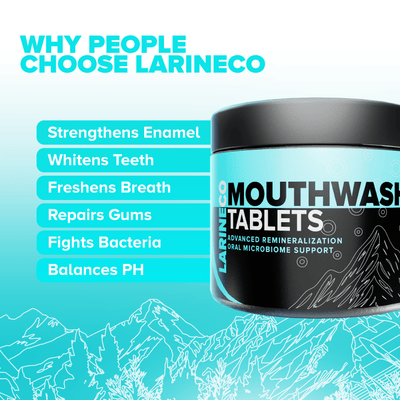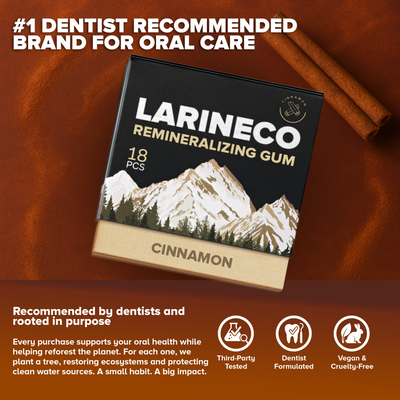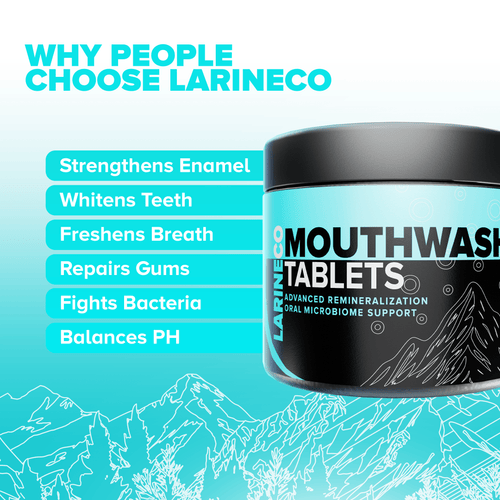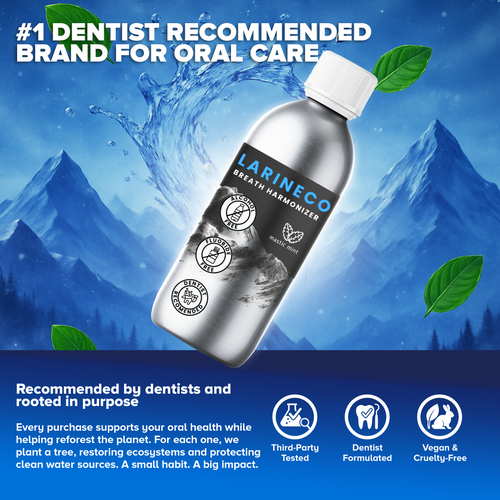From Ancient Resins to Enamel Repair: The Rise of Functional Chewing Gum
A Chew Through History – The Origin of Natural Gum Resins
Long before modern chewing gum-filled checkout aisles, people across cultures and centuries were chewing natural resins not for flavor or fun, but for their health. These natural substances weren’t synthetic or sugar-laden; they were powerful botanical gums derived from tree sap, valued for their antiseptic, astringent, and even spiritual properties. Ancient civilizations chewed these resins to clean their teeth, freshen their breath, soothe digestion, and strengthen oral health. Let’s look closer at three of the earliest natural gums: myrrh, spruce gum, and acacia (commonly known today as mastic).

Myrrh: Sacred Resin with Antiseptic Power
Harvested from the Commiphora tree native to Northeast Africa and the Arabian Peninsula, myrrh resin was one of the most treasured commodities of the ancient world. Its use dates back to at least 1500 BCE in Egypt, where it was employed for embalming, healing wounds, and as an offering in religious ceremonies. In oral care, myrrh was used as a mouthwash and chewing resin for its potent antiseptic and anti-inflammatory properties. It helped reduce gum swelling, combat infection, and soothe sore throats. Even today, you’ll find myrrh extract in some natural toothpastes and mouth rinses due to its antimicrobial action.
Spruce Gum: The Original Chewing Habit of North America
Long before the invention of commercial chewing gum, Indigenous peoples of North America were chewing the hardened resin of spruce trees. Spruce gum wasn’t just a pastime; it had a purpose. It was believed to clean the mouth, ward off illness, and act as a natural breath freshener. In the 19th century, spruce gum became the first commercial chewing gum in the United States, sold in wax paper or tins. Though it fell out of favor with the rise of sweeter, rubber-based gums, spruce gum still holds a place in natural and heritage wellness circles for its purity and old-world benefits.
Acacia (Mastic): The Tree Sap That Toned Gums
Often referred to historically as “Arabic gum” or “the tears of Chios,” mastic is a resin harvested from the Pistacia lentiscus tree, native to the Mediterranean. Used for over 2,500 years, mastic was chewed to promote oral hygiene, strengthen gums, and even aid digestion. Ancient Greeks and Romans praised it for its ability to freshen breath and tone the gums. Mastic has natural antibacterial and anti-inflammatory properties, making it one of the earliest and most effective botanical tools for gum health. Today, it's experiencing a resurgence among natural health enthusiasts, not just for oral benefits, but also for its gut-healing and antimicrobial potential.
H2: What Ancient Cultures Got Right About Oral Health
Despite lacking modern dental tools and synthetic additives, ancient cultures maintained remarkably good oral health through practices grounded in observation, utility, and consistency. They understood, even without lab coats and peer-reviewed journals, that what goes in your mouth daily has a cumulative effect, and they treated the mouth as part of the whole body's health, not an isolated system.
The Role of Mechanical Stimulation in Gum Health
One of the simplest yet most effective ancient techniques was mechanical stimulation, the physical act of cleaning the teeth and massaging the gums. Many cultures used chew sticks made from antibacterial tree twigs (like neem, miswak, or Salvadora persica). These weren't just brushes; they worked as soft abrasives that:
-
Removed food debris and surface plaque,
-
Stimulated blood flow in the gums, enhancing tissue resilience,
-
Exercised the jaw, helping maintain alignment and bone density.
Modern dentistry now recognizes that gum stimulation is critical for preventing gingivitis, other gum problems and maintaining healthy oral tissues, a principle ancient people practiced instinctively.
Antimicrobial Benefits Without Modern Additives
Ancient people weren’t brushing with triclosan-laced toothpaste or alcohol-heavy mouthwash. Yet, they kept oral pathogens in check through natural antimicrobial strategies:
-
Ayurvedic oil pulling with sesame or coconut oil helped reduce bacterial load and biofilm in the mouth, supporting the oral microbiome without killing it off entirely.
-
Spices and herbs like clove, cinnamon, neem, and myrrh were chewed or infused in rinses. These had well-documented antimicrobial properties and acted as natural deterrents against cavities and gum infections.
-
Fermented foods, common in ancient diets, helped balance the oral-gut axis, which we now know influences oral immunity.
In short, they didn’t need to nuke their mouths with antiseptics; they created a naturally balanced environment that discouraged pathogenic overgrowth.
Natural Gums vs. Synthetic Chewing Gums
Chewing was a daily habit, but it wasn’t recreational or sugar-laced. Ancient gums were made from natural resins (like mastic gum, chicle, or frankincense), each bringing health benefits:
-
Mastic gum, used in Greece and the Middle East, is still known for its plaque-fighting and antimicrobial properties.
-
Chicle, the original base for chewing gum in Mesoamerican cultures, was biodegradable and sugar-free; it encouraged saliva production without feeding harmful bacteria.
-
Frankincense resin was chewed not only for its flavor but also for its antiseptic and anti-inflammatory effects on the gums.
Compare that to modern gums made with synthetic rubber bases, artificial sweeteners, and plasticizers more designed for shelf-life than oral health. Ancient gums worked with the body, not against it.
Linking Ancient Wisdom to Today’s Needs
Why We Still Need Resin-Based Chewing Gum
Despite the convenience and popularity of modern synthetic chewing gums, there’s a compelling case for reintroducing natural resin-based gums into everyday oral care. These traditional gums, like mastic, chicle, and spruce resin, offer antimicrobial properties that don't rely on artificial sweeteners, preservatives, or plastic polymers. They naturally inhibit the growth of harmful oral bacteria, help prevent plaque buildup, and support a healthier oral microbiome, benefits that align with modern concerns about overprocessed products and chemical exposure.
Resin-based gums also last longer in the mouth, promoting extended chewing. This prolonged mastication increases saliva production, crucial for remineralizing teeth, buffering acids, and flushing away debris. Unlike synthetic gums, which can leach microplastics into the mouth or contribute to environmental pollution, natural resins are biodegradable and derived from renewable sources. In essence, they bridge the gap between ancient oral health practices and the growing demand for clean, sustainable wellness solutions today.
Gum Massage, Saliva Flow, and Microbiome Balance
One of the most overlooked but vital functions of chewing gum is mechanical gum massage, a benefit ancient cultures harnessed without necessarily understanding the biological mechanisms. Chewing stimulates blood flow in the gingival tissue, promoting nutrient delivery and cellular repair. This gentle, rhythmic pressure helps prevent gum recession and strengthens the tissues anchoring the teeth.
Equally important is the stimulation of saliva. Chewing increases saliva flow, which plays a defensive role in oral health: it neutralizes acids, washes away food particles, and delivers antimicrobial enzymes like lysozyme and lactoferrin. These enzymes help maintain microbial balance in the mouth, favoring beneficial bacteria while inhibiting pathogenic strains like Streptococcus mutans, one of the main culprits behind cavities.
The takeaway? Regular use of natural chewing gum can actively support the oral microbiome and prevent common dental issues, not just through ingredients, but through the simple act of chewing itself. It's an ancient practice that modern science is finally beginning to validate, one that links nervous system stimulation, oral immunity, and microbial diversity in ways synthetic gums simply can't replicate.
Where Nature Meets Science – Enter Nano-Hydroxyapatite
For centuries, natural resin-based gums have supported oral health through mechanical cleaning, antimicrobial effects, and stimulation of saliva. But as modern science advances, we now understand there’s a deeper layer to oral care, one that goes beyond cleaning to rebuilding. This is where nature meets science: with nano-hydroxyapatite (nano-HA), a bioactive compound that takes oral health into the realm of regeneration.
What is Nano-HA and why does It Matter for Enamel
Nano-hydroxyapatite is a synthetic version of the mineral that makes up 97% of tooth enamel and 70% of dentin. But unlike the coarse, crystalline form found in bones, nano-HA particles are engineered at a scale small enough to interact directly with microscopic defects in the enamel surface.

What does this mean in practice?
-
It fills in micro-lesions: Tiny cracks and pores on the enamel surface are smoothed over as nano-HA binds to them.
-
It integrates with natural enamel: Because its chemical structure is nearly identical to human enamel, nano-HA doesn’t just sit on the surface; it becomes part of the enamel matrix.
-
It protects and strengthens: This integration reduces sensitivity, reinforces enamel against acid attacks, and helps maintain a bright, healthy smile.
In short, nano-HA doesn’t just protect your teeth, it helps restore them.
Remineralization in Action: The Missing Piece in Ancient Gum Resins
Traditional resin gums like mastic or chicle have long been used for their antibacterial, anti-inflammatory, and cleansing properties. But they lack one crucial function: remineralization.
While ancient gums stimulate saliva and suppress harmful microbes, they cannot replace lost minerals or repair enamel damage caused by modern diets (acidic beverages, sugars, etc.). This is where ancient formulations fall short and where nano-HA steps in.
By incorporating nano-hydroxyapatite into a chewing gum base:
-
You bridge ancient preventative care with modern restorative science
-
You go beyond cleaning to healing
-
You address the core issue of tooth erosion and sensitivity in a way natural resins never could alone
From Resin to Regeneration: A Dual Approach
The future of oral care isn’t either natural or scientific; it’s both. A resin-based gum infused with nano-hydroxyapatite creates a synergistic effect:
-
Resins: Cleanse, reduce harmful bacteria, freshen breath, support gum health
-
Nano-HA: Actively repairs enamel, reduces hypersensitivity, restores mineral balance
This dual-action gum:
-
Stimulates the natural healing capacity of your mouth
-
Provides a steady supply of bioavailable calcium and phosphate ions
-
Helps maintain a balanced oral microbiome while strengthening the enamel structure
In essence, you’re not just chewing gum, you’re chewing a functional dental treatment that reflects both ancestral wisdom and cutting-edge biomaterial science.
Larineco’s Approach: Modern Gum Rooted in the Past
At Larineco, we believe that true innovation doesn’t discard the past; it refines it. Our resin-based chewing gum reimagines ancient oral care rituals using cutting-edge ingredients like nano-hydroxyapatite (nano-HA). By merging time-tested botanical resins with biomimetic science, we’ve developed a gum that does more than just freshen breath; it nourishes, protects, and restores the mouth as a whole system.
Combining Resins with Nano-HA for Complete Oral Care
Traditional cultures chewed tree resins like mastic or frankincense not just for flavor, but for their antimicrobial, astringent, and healing properties. These resins helped clean the teeth, strengthen the gums, and balance the oral environment, all without synthetic additives or sweeteners.
Larineco elevates that same idea with the addition of nano-hydroxyapatite, a scientifically validated mineral compound that mimics the structure of natural tooth enamel. Nano-HA fills in microscopic cracks, rebuilds surface enamel, and helps reduce sensitivity, something ancient resins couldn’t do alone.
This dual-action formula works synergistically:
-
Resins neutralize harmful oral bacteria, massage the gums, and stimulate protective saliva.
-
Nano-HA reinforces enamel structure and smooths the tooth surface, making it harder for plaque to stick.
Together, they address both hard and soft tissue needs, something no traditional gum or mouthwash can offer.
Targeted Benefits: Stronger Enamel, Healthier Gums, Cleaner Mouthfeel
Our approach isn’t cosmetic; it’s foundational. Each piece of Larineco remineralizing gum delivers a curated blend of benefits targeted to modern oral challenges:
-
Enamel Repair & Remineralization: Nano-HA penetrates weakened areas of the enamel, bonding to the surface and actively remineralizing the teeth.
-
Gum Support: Chewing action combined with anti-inflammatory resins improves blood flow to the gums, while natural antimicrobial agents reduce swelling and infection risk.
-
Balanced Microbiome: Instead of wiping out all bacteria like alcohol-based rinses, Larineco supports beneficial microbes while suppressing pathogenic ones, helping maintain a healthier oral ecosystem.
-
Clean Mouthfeel Without Chemicals: The unique resin texture promotes a mechanical cleansing effect, scraping off food particles and reducing plaque without relying on synthetic detergents or artificial flavors.
This is oral care that works with your body, not against it.
Why This Matters for Holistic Dental Wellness
Conventional dental care isolates problems: toothpaste for enamel, floss for plaque, and a rinse for breath. But your mouth isn’t a collection of parts; it’s a living system with feedback loops, immune responses, and microbial dynamics.
Larineco’s resin plus nano-HA gum bridges this gap. It treats the mouth as a whole: enamel, gums, saliva, and microbiome all supported at once simply by chewing. This isn't just more convenient; it’s more effective and sustainable.
In an age of overprocessed solutions and oral care products that disrupt more than they help, Larineco returns to a model of restorative function through natural synergy. We honor ancient wisdom and enhance it with modern science because your mouth deserves care that’s as intelligent as it is intuitive.
All in All: A True All-Rounder for Oral Health
Larineco’s gum is more than a modern chew; it’s a thoughtfully engineered solution that bridges ancient wisdom with today’s most advanced dental science. By combining traditional tree resins like mastic and chicle, long valued for their antibacterial and gum-strengthening properties, with nano-hydroxyapatite, the same mineral that makes up our teeth and bones, Larineco has created a product that truly works on every front. It strengthens enamel, nourishes gum tissue, neutralizes harmful bacteria, and leaves the mouth feeling clean and naturally refreshed. This fusion of bioavailable minerals and time-tested natural ingredients doesn’t just clean teeth; it actively supports long-term oral wellness. In an age where most gums are cosmetic or sugar-laden, Larineco stands apart as a functional, holistic tool for people who take their health seriously, starting with the mouth.










